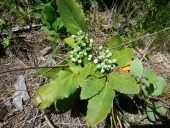posted 3 years ago
This is an oddball situation - its not anything hugely important, but since we are doing a focus on Woodland this week, seems a good time to throw it out there for discussion.
We came across an anomalous stump in our woods that I've been keeping an eye on since. I'm curious if others have seen similar odd stumps.
The stump is obviously a stump and was part of a thinning that must have happened 15 or 20 years ago. Though thinned, the trees are still too close together and the survey we were doing at the time was to mark further trees for thinning. The planned thinning didn't happen for a variety of distractions including the Covid years. I have revisited that patch of woodland intending to get around to that thinning (maybe 2023). Anyway, the other stumps that seem to be of the same vintage are pretty well rotted, but this particular specimen is completely covered over by bark and seems very much alive - albeit with no stem or leaves. I've seen trees where a large limb or one side of a double stemmed tree had been cut and the bark grew over the edges by an inch or so - but I'd not seen a stump act like this. I thought I had a picture of it, but can't locate it at the moment. Sometime in the future I'll find the stump again, take a snap and circle back to post it here. The bark covered stump itself from memory is maybe 10-12" in diameter, 15 to 20" tall and essentially flat on top, although somewhat rounded at the edges by the bark growth.
During a permaculture discussion on some website I visited, there was a discussion about trees acting in a seemingly 'altruistic' fashion, by pushing nutrients to seedlings that can't get enough sunlight themselves. That was cited as the explanation for saplings that are like 20+ years old, that haven't grown very tall, but which suddenly shoot up to replace a taller tree that is felled or brought down in the wind.
That explanation made me wonder whether this stump had been part of a group of trees the same age, and when it was felled in that thinning, continued to get enough nutrients from the surrounding trees via the roots, to keep the bark growing and covering over the stump. It might be too fanciful of me to think this tree had been part of a grouping and that its buddies clubbed together to continue to feed the stump to keep their friend alive. Perhaps the explanation is that various roots from the surrounding trees had fused with the roots from this tree, so there remained a flow of sap to this one.
My friend that was helping with the survey is keen to cut the stump off to compare the rings to other trees in that area when we do finally get around to thinning - but that's not going to happen. Any entity that has gone to that much trouble to stick around, in my mind deserves to be left to get on with life - and his nearest buddies will get preserved as well. However, I am considering purchasing a coring tool to drill a core from the side and maybe do a similar comparison of tree rings. I'm curious if the anomalous stump has been having new rings laid down right up to today.
Has anyone else come across anything like this?









